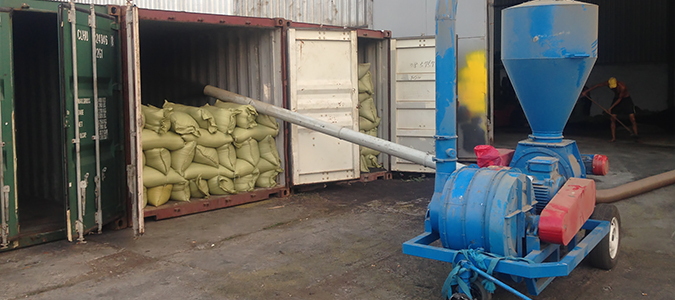Sealed dry container with a little changing makes transportation of bulk materials possible. Using of sea and railway containers for bulk goods has been known for long.  The container can withstand its maximum load capacity of 30 tons. Understanding the structure and the calculated density of all bulk goods it is easy to understand that the most common type of container which is operated for bulk cargoes is a 20 foot standard container. The principle of action when loading and unloading in such bulk containers is similar with railway wagon used in the shipment of grain or cement. Loading of the container goes through the top of the trumpet bell that is prepared in advance. Generally, each container planned to be used for sending of bulk goods is prepared strictly for the cargo that will be loaded in it. Inside the container is divided into zones and put plastic or, if possible, hardwood floors, so that the pressure in the container was uniform. After all preparatory work is done the container is tightly closed and goes for weighing. The weight of the obtained packaging is written in the invoice. When the container is prepared, you can start filling the cargo. The number of top bells can vary from one to 4 or more pieces.
The container can withstand its maximum load capacity of 30 tons. Understanding the structure and the calculated density of all bulk goods it is easy to understand that the most common type of container which is operated for bulk cargoes is a 20 foot standard container. The principle of action when loading and unloading in such bulk containers is similar with railway wagon used in the shipment of grain or cement. Loading of the container goes through the top of the trumpet bell that is prepared in advance. Generally, each container planned to be used for sending of bulk goods is prepared strictly for the cargo that will be loaded in it. Inside the container is divided into zones and put plastic or, if possible, hardwood floors, so that the pressure in the container was uniform. After all preparatory work is done the container is tightly closed and goes for weighing. The weight of the obtained packaging is written in the invoice. When the container is prepared, you can start filling the cargo. The number of top bells can vary from one to 4 or more pieces.
When the cargo is filled into the container uniformly and sealed, dry cargo 20 ft container should be weighed and the net weight of the goods in the container should be determined. The question of uniformity for bulk containers is also important; if the container is filled irregularly, then the container may fall on its side, causing damage to the truck. Further, the container goes up to the unloading point according to the route, where it once again put on the scales to check the coincidence of the data in the documents and the actual. The unloading of the goods takes place according to the scheme agreed between the recipient and the sender. There are  several options for unloading of bulk cargo from the container. The most common method is opening of end doors and lifting the container at the opposite end to the front of the ribs. Before the unloading of the container all internal spacers are getting out for facilitating the eruption of internal content. When the container is empty, the recipient organizes the cleaning of the walls and floor of the container.
several options for unloading of bulk cargo from the container. The most common method is opening of end doors and lifting the container at the opposite end to the front of the ribs. Before the unloading of the container all internal spacers are getting out for facilitating the eruption of internal content. When the container is empty, the recipient organizes the cleaning of the walls and floor of the container.
Cleaning of the container is obligatory even if it will be used for load; old remnants can harm the state of the container. On the way back free dry cargo container can be used for any load, which will be confirmed by the owner of the container. To avoid the return charges the container is loaded with appropriate goods on the way back. This reusable packaging can be used as many times as desired. Container shipment of bulk cargo usually allows achieving savings of 15-20% in comparison with specialized railway and road rolling stock.















